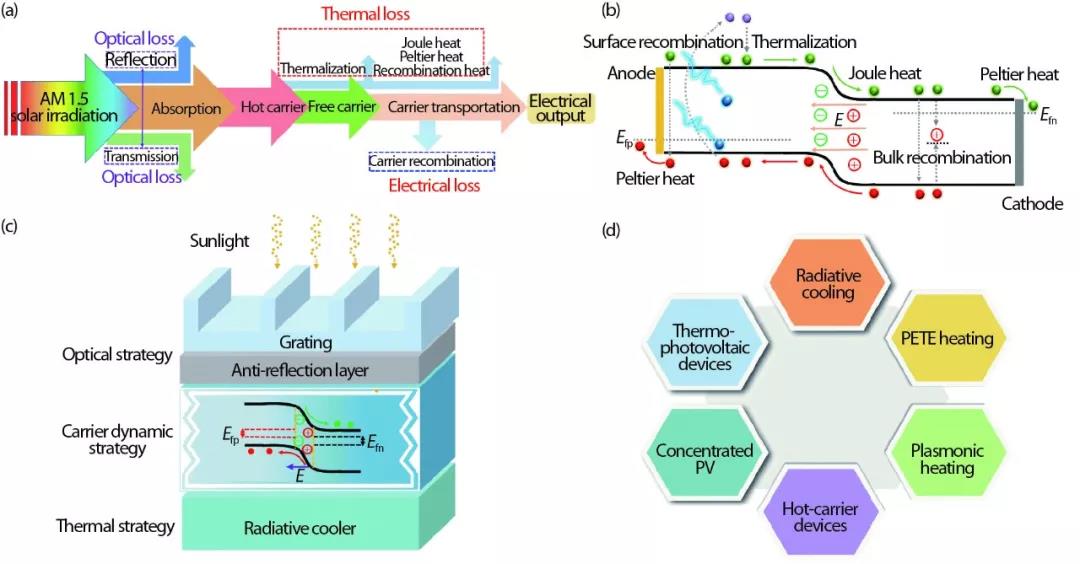博文
专家视点 | 李孝峰:太阳能电池光电热模拟技术
|
目前,各类单结光伏器件的光电转换效率普遍低于27%,随着效率越接近热力学定义的光电转换效率极限,进一步提升就越发困难。光伏等光电转换器件中蕴含了光-电-热耦合的系列多物理机制,在实验中很难衡量各种机制所造成的损耗大小,也很难提出综合性的优化策略。通过多维度的光电热耦合模拟,深入研究光伏器件中的光电热耦合机制并量化分析降低损耗的策略,可以有效推动光伏器件光电转换效率的进一步提升。
在最新出版的《半导体学报》2019年第5期上,苏州大学光电科学与工程学院李孝峰教授课题组介绍了光伏器件的光电热耦合模拟技术,呈现了光伏器件中存在的各种微观的损耗机制。李教授指出通过高精度的光电热耦合仿真技术可以精确的对各类光电热器件物理进行量化,为器件研究开发提供先进的设计方案和优化思路。
The solar cells (SCs) are the most typical devices used to convert the solar energy into electricity to help relieving the energy shortage crisis. In the photovoltaic (PV) communities, improving the power-conversion efficiency (PCE) of SC keeps to be a long-term objective. In the past decades, enormous efforts have been paid on exploring various new structural scenarios or PV mechanisms (e.g., near-field thermophotovoltaic and hot-carrier SCs) in order to approach or even break the Shockley-Queisser (SQ) efficiency limits of various SCs[1]. However, besides the perovskite SCs[2], the rate of efficiency improvement is extremely slow in the past decade, especially for the traditional semiconductor-based SCs. In practice, for a high-performance SC, a comprehensive optimization should simultaneously consider increasing the optical absorption, improving the electrical collection efficiency, and controlling the thermodynamic effect[3, 4]. The challenge lies in that managing the SC operation is accompanied by the coupled photoelectric, photo-thermal and thermoelectric processes, which have to be managed from the perspectives of operation basics, material systems, structural designs and fabrication feasibilities. Such a multi-domain and multi-physical behavior can hardly be estimated conveniently in experiments (even in theoretical calculations or simulations), so that the performance improvement by balancing the optical, electrical, and thermal effects is very challenging. For instance, the transportation of photocurrent is not just regulated by the temperature, but also accompanied by the emission of photons and the generation of heat that affect the temperature of SC. Therefore, in order to further enhance the SC efficiency, it is necessary to thoroughly investigate the coupled multiphysical effect from the complete opto-electro-thermal (OET) domains.
The recent research proposes the full-coupled OET simulation technology of SC[5], which reveals the fundamental physical mechanisms in SCs by addressing the coupled optical, electrical and thermal effects simultaneously[5, 6]. The OET simulation technology interprets the energy conversion and dissipation paths inside the SC system from both macroscopic and microcosmic perspectives, as plotted in the Fig. 1. For the photovoltaic system, the energy losses and conversion processes can attribute to three channels (i.e., optical, electrical and thermal ways), as shown in Fig. 1(a). Based on the OET model of SC, firstly, the energy loss flows by optical effects can be estimated by examining the reflection, absorption, and transmission characteristics of the SC. Then, with quantifying the carrier electrodynamic behaviors (i.e., generation, transportation, recombination, and collection processes), the electrical losses can be estimated. Finally, addressing the carrier thermodynamic behaviors (e.g., thermalization, recombination heat, Joule and Peltier heat) in the SC, the thermal effect and the operation temperature of SC can be predicted, as shown in Fig. 1(b). All these energy losses via various channels can be readily obtained under the OET simulation technology.

Figure 1. (Color online) (a) Schematic diagrams of energy flow distribution in SCs under sunlight illumination. (b) The carrier thermodynamic physics in SCs. (c) The schematic diagrams of optical, electrical and thermal optimization strategy applied in the SC. (d) The possible applications of the OET simulation technology[5].
With quantitatively analyzing the energy losses in SCs by the OET simulation, the optimization can be achieved very conveniently, as shown in the Fig. 1(c). From the optical perspective, introducing an anti-reflection layer or back-reflection mirror is the basic optimization strategy. Besides, with the development of the photonic crystal, the optical absorption can be greatly enhanced by designing various light-trapping structures (e.g., gratings or pyramids)[7]. From the electrical perspective, the photogenerated electron-hole pairs suffer from the serious recombinations[8]. Thus, by tailoring the doping concentration and engineering the energy band alignment, the electrical performance of SC can be effectively managed[9]. From the thermodynamic perspective, the temperature dependence of the performance of SC can be examined so that thermal controlling strategies can be introduced, e.g., the radiative cooler[10].
In summary, the coupled OET simulation technology provides a feasible way for comprehensively exploring the fundamental physics and light-matter interactions in photovoltaic devices so that high-performance SCs can be achieved. Besides, more extensive optoelectronic devices (e.g., photodetectors, light-emitting diodes) as being exemplified in Fig. 1(d) can be studied by extending the current OET model with introducing the corresponding physics[11], enabling a device-level and accurate design of the various optoelectronic devices.
References
[1] Green M A, Bremner S P. Energy conversion approaches and materials for high-efficiency photovoltaics. Nat Mater, 2017, 16(1), 23
[2] Best Research-Cell Efficiencies (NREL, 2019) https://www.nrel.gov/pv/assets/pdfs/best-reserch-cell-efficiencies.20190411.pdf.
[3] Polman A, Knight M, Garnett E C, et al. Photovoltaic materials: Present efficiencies and future challenges. Science, 2016, 352(6283), aad4424
[4] Polman A, Atwater H A. Photonic design principles for ultrahigh-efficiency photovoltaics. Nat Mater, 2012, 11(3), 174
[5] Shang A, Li X. Photovoltaic devices: opto-electro-thermal physics and modeling. Adv Mater, 2017, 29(8), 1603492
[6] Shang A, An Y, Ma D, et al. Optoelectronic insights into the photovoltaic losses from photocurrent, voltage, and energy perspectives. AIP Adv, 2017, 7(8), 085019
[7] Li X, Hylton N P, Giannini V, et al. Bridging electromagnetic and carrier transport calculations for three-dimensional modelling of plasmonic solar cells. Opt Express, 2011, 19(104), A888
[8] Li X, Hylton N P, Giannini V, et al. Multi-dimensional modeling of solar cells with electromagnetic and carrier transport calculations. Prog Photovolt: Res Appl, 2013, 21(1), 109
[9] An Y, Shang A, Cao G, et al. Perovskite solar cells: optoelectronic simulation and optimization. Solar RRL, 2018, 2(11), 1800126
[10] Zhu L, Raman A P, Fan S. Radiative cooling of solar absorbers using a visibly transparent photonic crystal thermal blackbody. PNAS, 2015, 112(40), 12282
[11] Piprek J. Semiconductor optoelectronic devices: introduction to physics and simulation. Elsevier, 2013

点击阅读李孝峰教授文章:
Opto-electro-thermal simulation technology of solar cells
Yidan An, Yue Zhao, Tianshu Ma and Xiaofeng Li
J. Semicond. 2019, 40(5), 050403
doi: 10.1088/1674-4926/40/5/050403

扫描二维码关注获得更多信息
https://blog.sciencenet.cn/blog-3406013-1180289.html
上一篇:专家视点 | 陈建军:半导体胶体量子点在片上微纳激光器方面的应用
下一篇:专家视点 | 黎华:半导体太赫兹光频梳